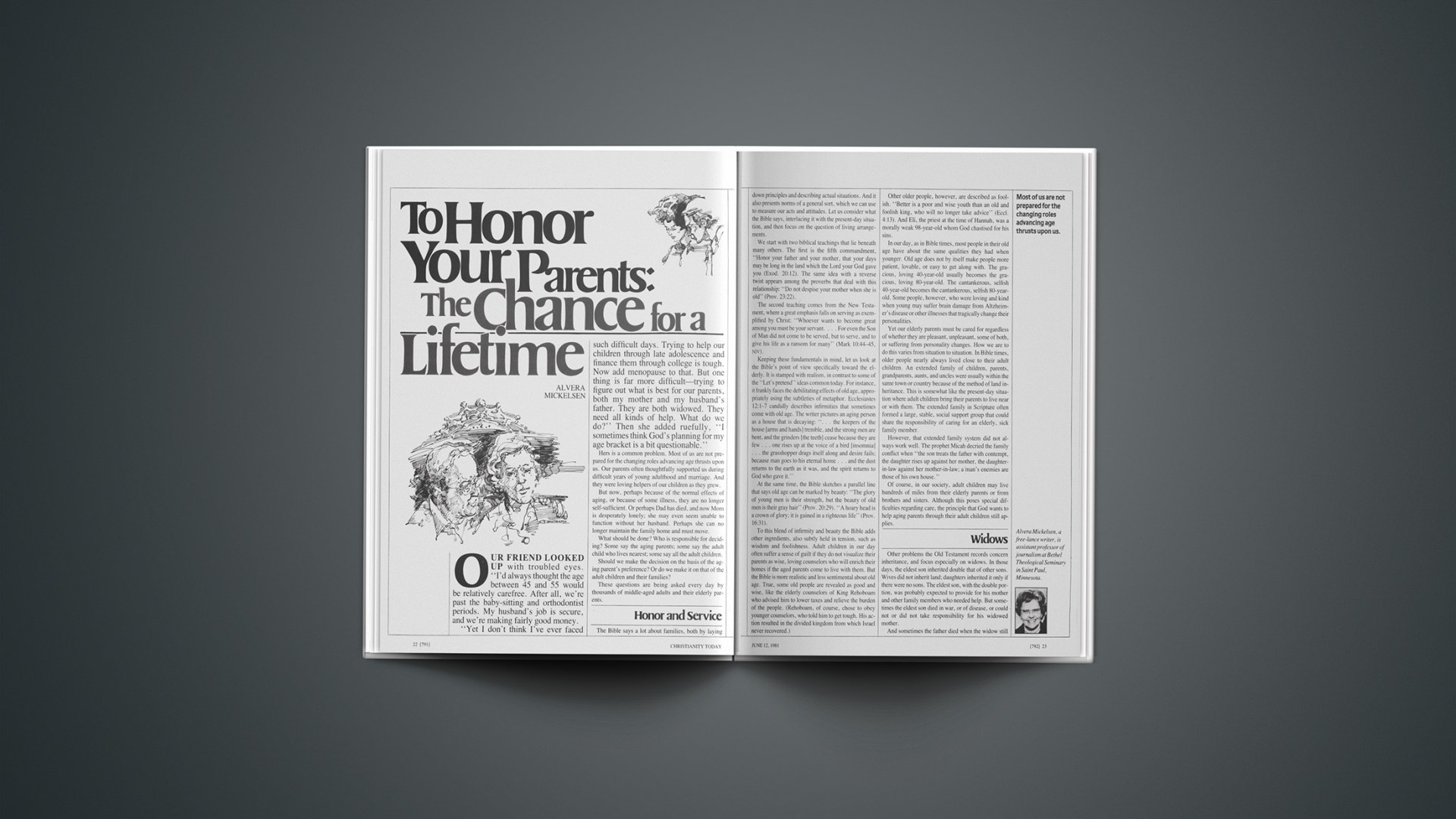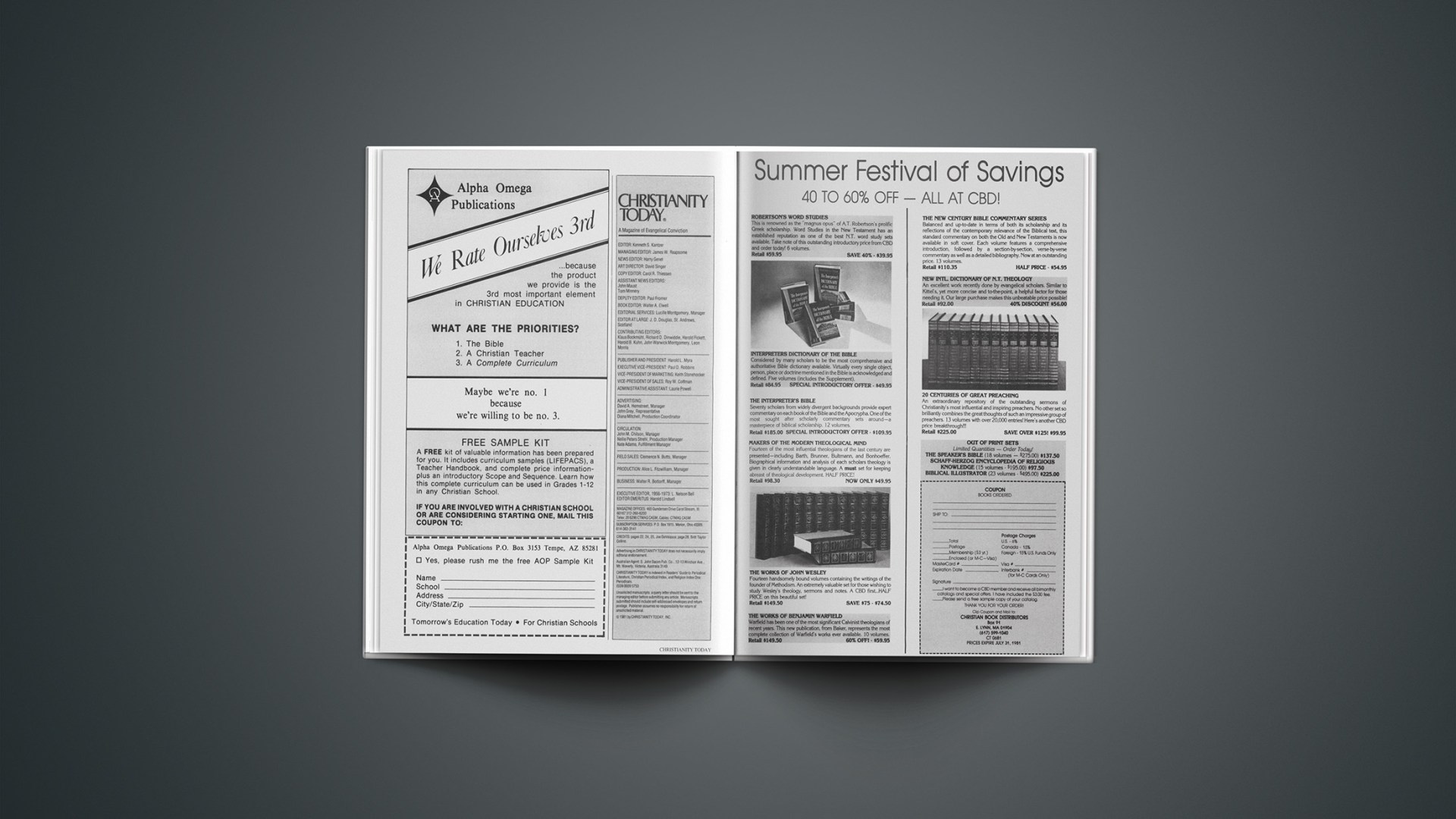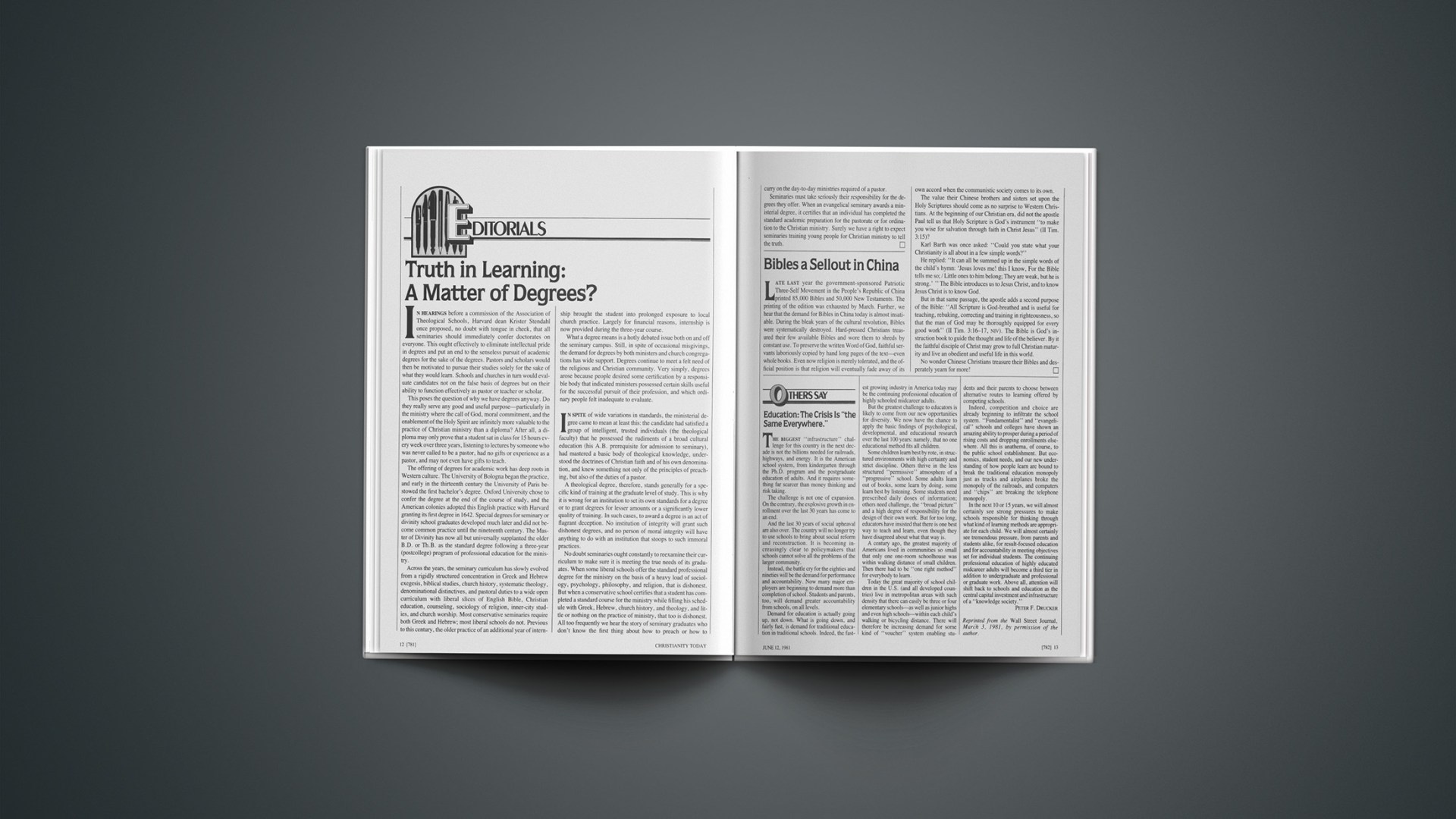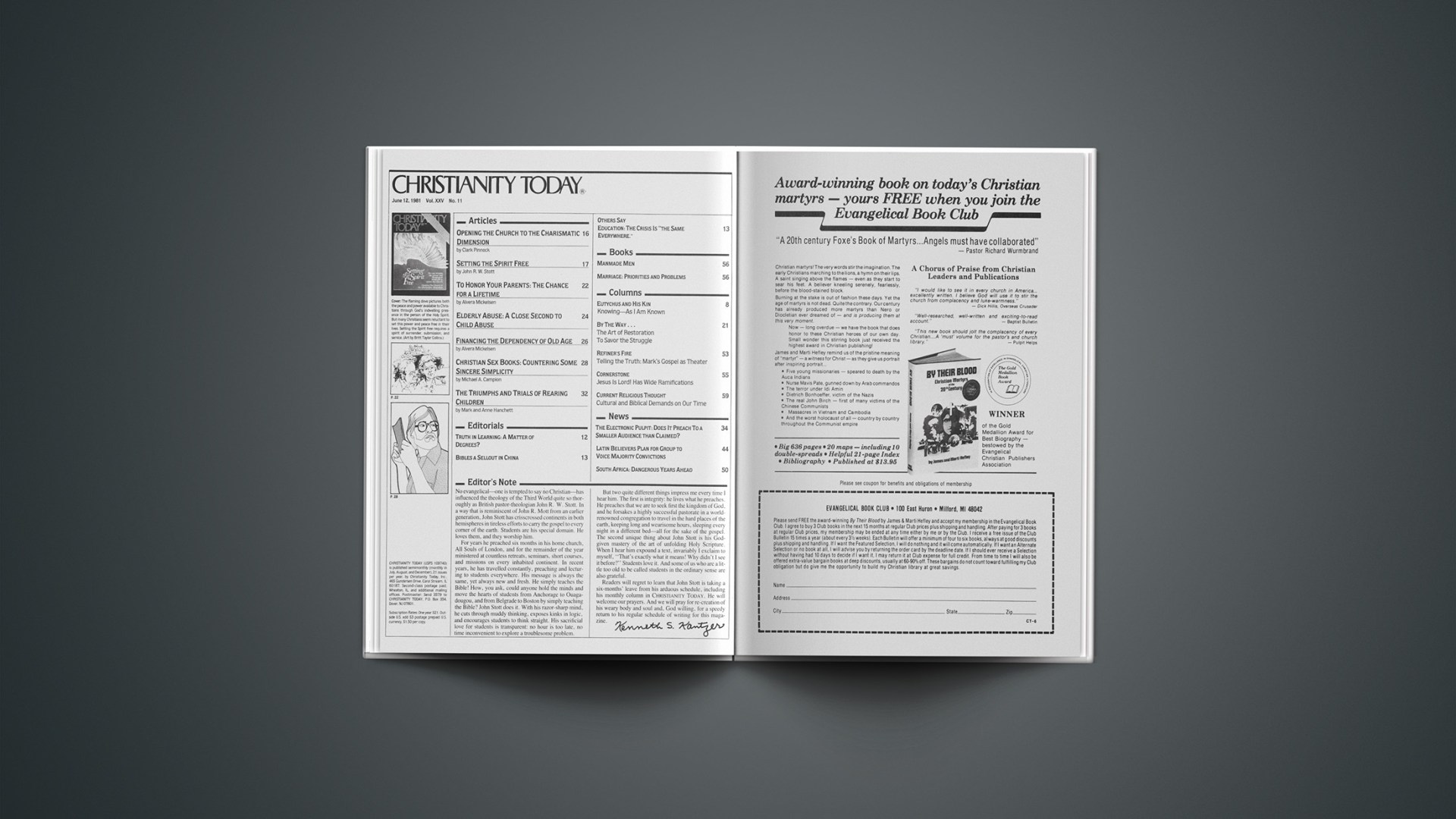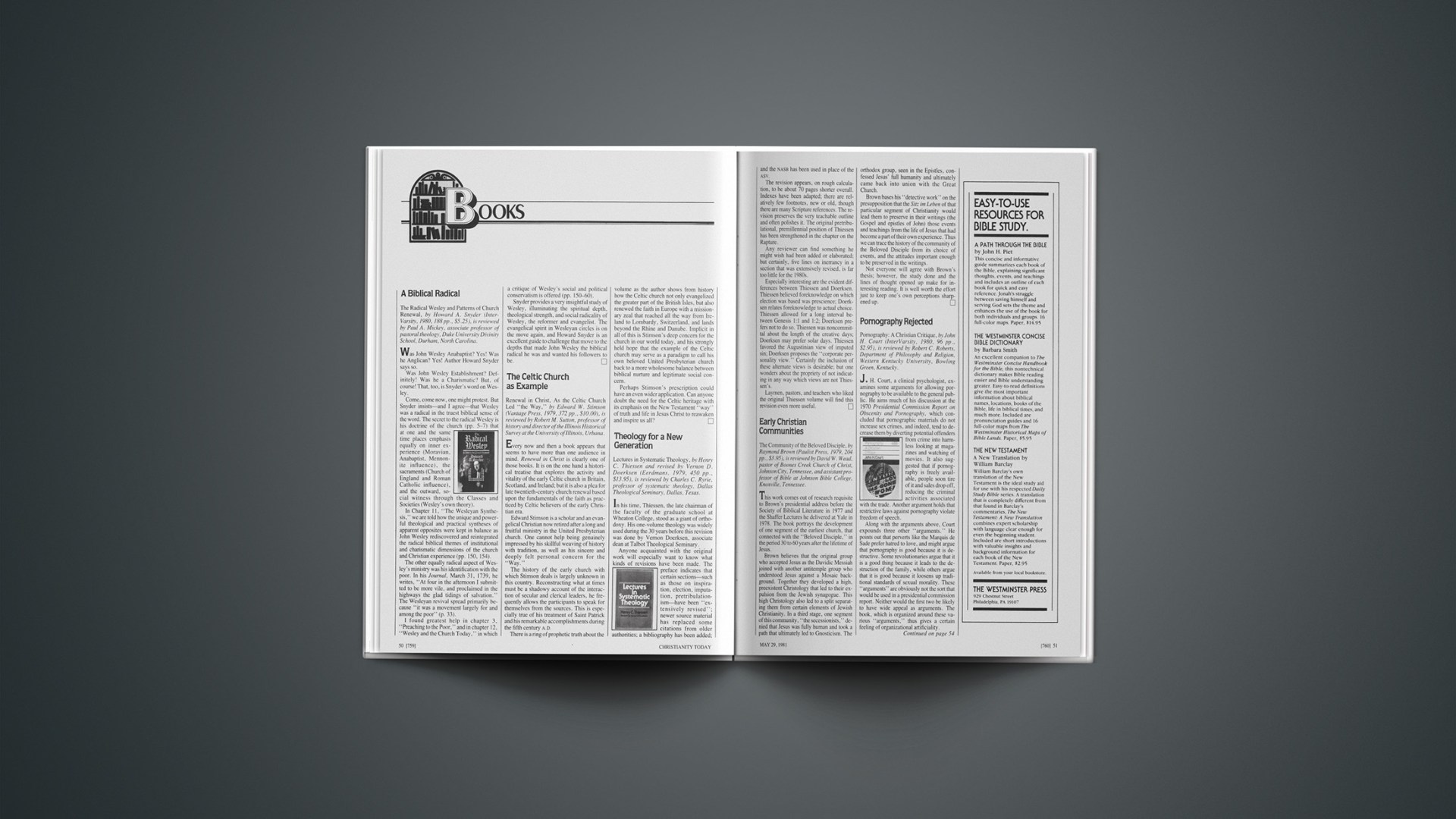Our friend looked up with troubled eyes. “I’d always thought the age between 45 and 55 would be relatively carefree. After all, we’re past the baby-sitting and orthodontist periods. My husband’s job is secure, and we’re making fairly good money.
“Yet I don’t think I’ve ever faced such difficult days. Trying to help our children through late adolescence and finance them through college is tough. Now add menopause to that. But one thing is far more difficult—trying to figure out what is best for our parents, both my mother and my husband’s father. They are both widowed. They need all kinds of help. What do we do?” Then she added ruefully, “I sometimes think God’s planning for my age bracket is a bit questionable.”
Hers is a common problem. Most of us are not prepared for the changing roles advancing age thrusts upon us. Our parents often thoughtfully supported us during difficult years of young adulthood and marriage. And they were loving helpers of our children as they grew.
But now, perhaps because of the normal effects of aging, or because of some illness, they are no longer self-sufficient. Or perhaps Dad has died, and now Mom is desperately lonely; she may even seem unable to function without her husband. Perhaps she can no longer maintain the family home and must move.
What should be done? Who is responsible for deciding? Some say the aging parents; some say the adult child who lives nearest; some say all the adult children.
Should we make the decision on the basis of the aging parent’s preference? Or do we make it on that of the adult children and their families?
These questions are being asked every day by thousands of middle-aged adults and their elderly parents.
Honor And Service
The Bible says a lot about families, both by laying down principles and describing actual situations. And it also presents norms of a general sort, which we can use to measure our acts and attitudes. Let us consider what the Bible says, interlacing it with the present-day situation, and then focus on the question of living arrangements.
We start with two biblical teachings that lie beneath many others. The first is the fifth commandment, “Honor your father and your mother, that your days may be long in the land which the Lord your God gave you (Exod. 20:12). The same idea with a reverse twist appears among the proverbs that deal with this relationship: “Do not despise your mother when she is old” (Prov. 23:22).
The second teaching comes from the New Testament, where a great emphasis falls on serving as exemplified by Christ: “Whoever wants to become great among you must be your servant.… For even the Son of Man did not come to be served, but to serve, and to give his life as a ransom for many” (Mark 10:44–45, NIV).
Keeping these fundamentals in mind, let us look at the Bible’s point of view specifically toward the elderly. It is stamped with realism, in contrast to some of the “Let’s pretend” ideas common today. For instance, it frankly faces the debilitating effects of old age, appropriately using the subtleties of metaphor. Ecclesiastes 12:1–7 candidly describes infirmities that sometimes come with old age. The writer pictures an aging person as a house that is decaying: “… the keepers of the house [arms and hands] tremble, and the strong men are bent, and the grinders [the teeth] cease because they are few … one rises up at the voice of a bird [insomnia] … the grasshopper drags itself along and desire fails; because man goes to his eternal home … and the dust returns to the earth as it was, and the spirit returns to God who gave it.”
At the same time, the Bible sketches a parallel line that says old age can be marked by beauty: “The glory of young men is their strength, but the beauty of old men is their gray hair” (Prov. 20:29). “A hoary head is a crown of glory; it is gained in a righteous life” (Prov. 16:31).
To this blend of infirmity and beauty the Bible adds other ingredients, also subtly held in tension, such as wisdom and foolishness. Adult children in our day often suffer a sense of guilt if they do not visualize their parents as wise, loving counselors who will enrich their homes if the aged parents come to live with them. But the Bible is more realistic and less sentimental about old age. True, some old people are revealed as good and wise, like the elderly counselors of King Rehoboam who advised him to lower taxes and relieve the burden of the people. (Rehoboam, of course, chose to obey younger counselors, who told him to get tough. His action resulted in the divided kingdom from which Israel never recovered.)
Other older people, however, are described as foolish. “Better is a poor and wise youth than an old and foolish king, who will no longer take advice” (Eccl. 4:13). And Eli, the priest at the time of Hannah, was a morally weak 98-year-old whom God chastised for his sins.
In our day, as in Bible times, most people in their old age have about the same qualities they had when younger. Old age does not by itself make people more patient, lovable, or easy to get along with. The gracious, loving 40-year-old usually becomes the gracious, loving 80-year-old. The cantankerous, selfish 40-year-old becomes the cantankerous, selfish 80-year-old. Some people, however, who were loving and kind when young may suffer brain damage from Altzheimer’s disease or other illnesses that tragically change their personalities.
Yet our elderly parents must be cared for regardless of whether they are pleasant, unpleasant, some of both, or suffering from personality changes. How we are to do this varies from situation to situation. In Bible times, older people nearly always lived close to their adult children. An extended family of children, parents, grandparents, aunts, and uncles were usually within the same town or country because of the method of land inheritance. This is somewhat like the present-day situation where adult children bring their parents to live near or with them. The extended family in Scripture often formed a large, stable, social support group that could share the responsibility of caring for an elderly, sick family member.
However, that extended family system did not always work well. The prophet Micah decried the family conflict when “the son treats the father with contempt, the daughter rises up against her mother, the daughter-in-law against her mother-in-law; a man’s enemies are those of his own house.”
Of course, in our society, adult children may live hundreds of miles from their elderly parents or from brothers and sisters. Although this poses special difficulties regarding care, the principle that God wants to help aging parents through their adult children still applies.
Widows
Other problems the Old Testament records concern inheritance, and focus especially on widows. In those days, the eldest son inherited double that of other sons. Wives did not inherit land; daughters inherited it only if there were no sons. The eldest son, with the double portion, was probably expected to provide for his mother and other family members who needed help. But sometimes the eldest son died in war, or of disease, or could not or did not take responsibility for his widowed mother.
And sometimes the father died when the widow still had young children. Then she was apparently left to her own limited resources and to the charity of other people. Widows were powerless and often exploited so that throughout the Bible, “widow” is almost a synonym for poverty.
Time has not changed that. In the United States today, 72 percent of the elderly poor are unmarried women. In 1977, the median income for women over 65 years of age was $3,088, while men over 65 had a median income of $5,526. Current statistics indicate that the average wife outlives her husband by at least seven years.
In biblical times, widows were dependent on charity. In our times, elderly women are also often dependent on charity, supplemental social security benefits, general welfare, Medicaid, and so on.
The Mosaic law said that part of the tithe given the Levites was to feed the widows and fatherless. When a field was harvested, owners were told not to go back and pick up the stalks of grain the reapers overlooked, but to leave them for the widows and fatherless. (It was in such gleaning that Ruth met Boaz.)
In the Gospels we see that Jesus was particularly aware of the poverty of widows. He raised from the dead the only son of the widow of Nain, thereby providing for her material as well as emotional needs. He commented on the widow in the temple who gave to the treasury “all that she had,” two pence.
The first century boasted no social security system, no Medicaid. Many widows in the early church had no one to care for them—partly because, as in our day, family members ignored their needs.
Perhaps because of this Paul wrote Timothy that widowed women of child-bearing age should remarry so that they would not become dependent on the church for material needs. However, old women who did not have relatives who would care for them were to be cared for by the young church.
In this context, Paul states that adult children are responsible to care for their elderly parents. “If a widow has children or grandchildren, let them first learn their religious duty to their own family and make some return to their parents; for this is acceptable in the sight of God.… If any one does not provide for his relatives, and especially for his own family, he has disowned the faith and is worse than an unbeliever.… If any believing woman has relatives who are widows, let her assist them; let the church not be burdened, so that it may assist those who are real widows” (1 Tim. 5:4, 8, 16). Paul apparently speaks of “real widows” as those who have no family to care for them.
Some signs of family breakdowns today are battered wives, abused children, and abused elderly parents. Many of these same sins were present in Old Testament Judaism and in the time of the early church. Psalm 71:9 shows that being cast off in old age was a familiar experience. Part of the message of John the Baptist as a forerunner of Christ was that he “will turn the hearts of the fathers to the children and the hearts of the children to their fathers.”
Abuse of elderly parents is not limited to non-Christians. It takes many forms, in addition to the violent ones of actual beating or slow starvation.
We can see one abuse in the effort to gain control of the elderly parent’s assets. They do not belong to the children unless the parent chooses to assign them during his life, or through his will. The Bible speaks specifically to this point: “He who robs his father or his mother and says, ‘That is no transgression,’ is companion of a man who destroys” (Prov. 28:24).
Sometimes a parent is clearly unable to manage his or her financial affairs, and an adult child (or someone else) must take over this responsibility, either as a court-appointed conservator, or in an informal arrangement. Unfortunately, the adult child occasionally moves the parent’s assets into his own account and then places the parent on welfare. The way an adult child uses the assets of an incompetent parent is a true test of his integrity. By law, such assets are to be used only for the care and support of the parent.
Neglect is another kind of abuse. This may involve leaving the care of a needy parent to neighbors or friends or to the one adult child of the family who is willing and compassionate. This kind of neglect is surely what Paul was talking about when he wrote, “If anyone does not provide for his relatives, and especially for his own family, he has disowned the faith and is worse than an unbeliever.”
Adult children who live a long distance from their parents (a phenomenon almost unknown in Bible times) may not be able to be with their parents in times of failing health, but they can help in other ways. They can share expenses. They can frequently phone the parent or those who are caring for him. They can write often; they can visit as often as possible. Sometimes the only real interest adult children seem to show in a parent comes after the funeral, when they are eager to make sure they got equal treatment in the will with the family member who may have spent several years physically and financially caring for him!
Treating the elderly parent like a child is also abuse. “Honoring our father and mother” surely involves helping them maintain some control over their lives as long as possible. We do not honor our parents when we make all the decisions about care without letting them participate. We can openly discuss their feelings about where they are living, their fears for the future, their possible options for the future; these matters all contribute a great deal to our parents’ dignity. Sometimes an adult child must make a hard decision about care because the aged parent is not mentally able to participate, or because the parent refuses to accept the necessity for additional medical care. This is not so likely to occur if they have all openly discussed the options over a period of time.
We can also hurt the elderly by cutting them out of family and church activities. Peter at Pentecost indicated in quoting the prophet Joel that all age groups were to participate in a Spirit-filled church: “Your young men shall see visions, and your old men shall dream dreams” (Acts 2:17). Often extra effort is necessary to keep older persons active in church life when they are no longer totally self-sufficient. Someone may need to drive them to church and home. Churches have not been quick to conform to laws regarding access for the handicapped. Wheelchairs are not difficult to transport in cars, and every church should have at least one easy access route. A loving, responsible, adult child will make extra effort to get his elderly parent to church as long as the parent wants to go.
Modern medicine is now saying that satisfying social contacts are essential for good health and mental alertness. Dr. James Lynch of the University of Maryland School of Medicine says that lack of contact with other people can lead to serious illness, especially heart disease.
Living Arrangements
The question many adult Christians are facing is, “How can I meet the needs of my elderly parents and still handle my other responsibilities? How do I honor my father and mother when a change in their living arrangement has to be made?” Is the loving and honoring course always to take the aging parent into the home of the adult child?
In some families, the presence of a grandmother or grandfather within the family circle is a blessing to all, but this is not always so.
I once asked a college friend about her home life. “What home life? We didn’t have any,” she replied. She explained that her grandmother had lived with the family all during her childhood and youth. “All our activities were determined by ‘How will Grandma feel about it?’ If it would have annoyed Grandma, it couldn’t be.” All the children in the family left home at the earliest possible time, largely to get away from Grandma.
No doubt my friend’s mother would have felt guilty if she had not taken in her mother when she was widowed. Yet both grandmother and the rest of the family would probably have been better off if they had made some other arrangement. Grandma may have been as miserable as the children, but thought living with her daughter was the only “respectable” thing to do. And perhaps for financial reasons she had no other choice.
Not every older person wants and or is emotionally equipped to live in the middle of a busy family of children and teen-agers. Many would be happier in the peace and quiet of their own apartment in a building reserved for senior citizens, or in a retirement center where they can build a circle of their own friends and maintain some independence. However, almost every older person needs and wants frequent contact with his children and grandchildren.
Some elderly parents hesitate to pay the fee to enter a retirement community because they want their children to inherit as much of their resources as possible. Or they may fear that their money “won’t last as long as we do.” The children should recognize and discuss such factors with them freely.
My husband’s father lived alone until he was 86—ten years after his wife died. We were living 400 miles away and my husband was an only child. We were uncomfortable with the situation. We called him every week, went to see him a few times a year, and had him visit us once or twice a year. After he had surgery at age 86, the doctor advised us that he should not go back to his home to live alone.
In considering what to do, we knew he would find it difficult to adjust to life in our household with active teen-agers. For example, he liked to go to bed at 8 and get up at 5 A.M. (He also thought all of us ought to go to bed at 8 and get up at 5!) He loved us and our children—in small doses. But we knew he needed a lot of solitude, as he always had.
We found a place for him in a lovely retirement center only three miles from our home. There he had his own room and private bath and TV set. He went to the dining room for three nourishing meals a day and could visit with people when he wanted to. There was a chapel service on Sunday. He could sleep when he desired. I visited him almost every day and the rest of the family visited often. We took him shopping when he was willing, brought him to our home as often as he would come. He did not want to come often because he was much more secure with a definite routine—where everything happened at an exact, specified time of day. He lived there for six years, until his death at 92.
We think he was much more content there than he would have been in our home, and those six years were among the best in his life. He needed to be in control of his space—however small.
How to honor our mother and our father is an intensely personal matter, to be worked out between the parents and adult children, taking into consideration the welfare and resources of all. Love and honor for our parents often demand sacrifices of time, money, and emotional energy to find the most Christian way to meet the needs of all concerned.
But following God’s commands has its own rewards. “God is able to make all grace abound to you, so that in all things at all times, having all that you need, you will abound in every good work” (2 Cor. 9:8, NIV).

